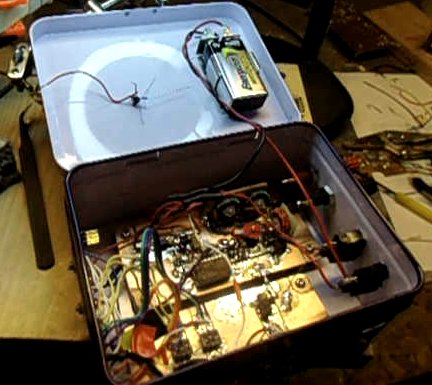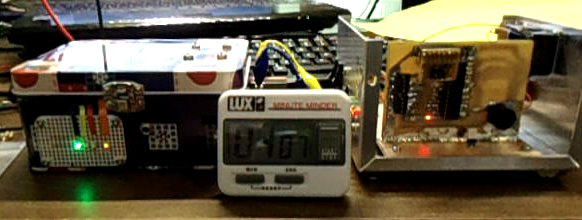27 — Success! And Sucess Again! The incredible weekend - 80m transmitter and OSH Park ATmega328 boards.
2015-07-05. By Patrick.

Fig. 1. The transistor lying to the inside lid of the transmitter and base resistor assembly lying on the inside of the transmitter lid and ready to be soldered in. The base went to the defective pin on the AVR. The emitter went to the oscillator it was controlling. And the collector went to the regulated +5 V.
Truly. This last weekend was incredible. As many of you know, we have been building an 80 m transmitter for ARDF. And we had some ATmega328 TQFP breakout boards made by OSH Park. These related projects started around November last year and have been stalled since December.
The hope -- After we completed our first 80 m transmitter, we wanted to make the second one a bit smaller so that it would be easier to carry while running in the woods. We could get great space savings by having PCBs made and using smaller components. Having PCBs made would also save much time. Be we had never done this before. So we decided that we would have just the controller module PCB made. The controller module carries an ATmega328 which reads switches, controls LEDs, and controls the oscillator for the transmitter. And we could make stuff really small by using the TQFP version of the ATmega328 (7 mm x 7 mm) instead of the DIP version. We had been looking at the OSH Park service for a while so we designed some PCBs and had them made. I also tried to hand-make a copper board for the TQFP.
The frustration -- The following happened over months during which the projects crawled slowly along as we had to concentrated on designing and directing an orienteering meet and running a maker space at the school. I managed to get part of the hand-made controller board completed. But what a nightmare dealing with the tiny spacing on the TQFP. I soldered on just enough to test it. It worked but that's where that project ended. The OSH Park boards arrived in December. What excitement! Still it was a while before all the parts were soldered on and tested. Fail! Over the months I grabbed an hour here and there to test different parts but had more theories about what was wrong than clues. Each individual check and test worked, but the boards could not communicate with the hardware programmer. I had never soldered a TQFP before and I started to suspect that I had damaged the chips with heat during soldering.
Almost there -- I did have one working board. The hand-made one. It didn't have all the pins but, by re-writing the code, I could make use of what it had and get a transmitter built. It would have limited capabilities, but it would be ready now. So I finished building the transmitter with this board, programmed it, and tested it. It almost worked. Some of the inputs didn't work as expected. And the oscillator wouldn't come on. After checking the code and measuring voltages on the pins, I notices that the to the oscillator had a voltage of 2.1 V. That was really strange. Possibly, it would read 0 V if I had made an error in the code. But how did it read in between when the traces and minor components had been well tested. Unless... Maybe the chip was damaged. Here was another clue that heat may have been the problem.
Success 1, the crazy hardware kludge -- It was Saturday. We were so close, so so close. And desperately wanted to get out this weekend for our first ever practice ARDF run with two transmitters we had built ourselves. I cut the wire from the AVR to the switch and soldered on a transistor to boost the signal to 5 V when the pin put out 2.1 V. And it worked! Happy day!
Success 2 -- Sunday. All this work really pointed to damaged chips. Something I had never encountered. So I unsoldered the chip from one of the OSH Park boards and soldered a new one on using a much lower temperature and only give short duration touches with the iron. And it worked! The hardware program talked to the AVR and test LEDs were blinking happily. We had a second unresponsive OSH Park board. I changed the AVR and did a bit of troubleshooting to find a short. And suddenly we had two working boards. Happy day number 2!
The recompense -- That Sunday we went out in the woods and had a blast searching for the transmitters. And we have a couple fully working ATmega328 boards which can be reprogrammed as controller modules for the kludgy one on the 80m transmitter. But the recompense is really all in this great feeling of success. I keep thinking back about all that was learned on the way. And remembering the perseverance, working at it here and there when other duties took up most of the day. It was all worth it.

Fig. 2. The finally completed new transmitter on the left in synch with our first transmitter. The new transmitter was transmitting on odd minutes and the old one on even minutes. The timer shows 4'07" and a red LED can be seen on the old transmitter as it sends out its call.